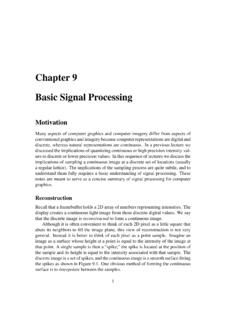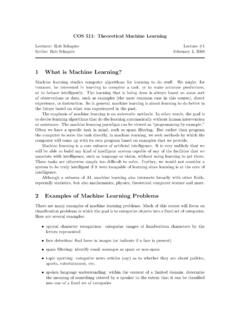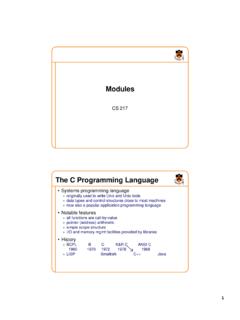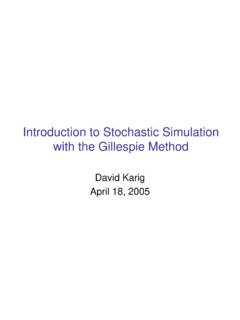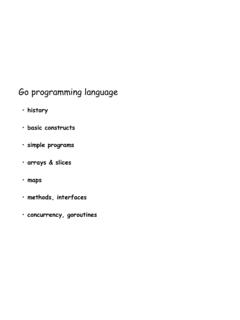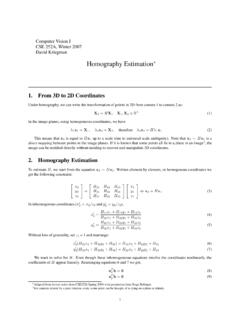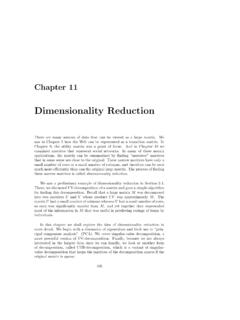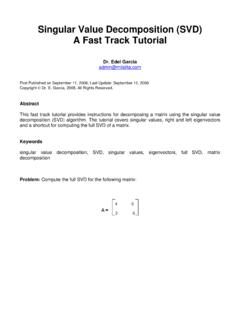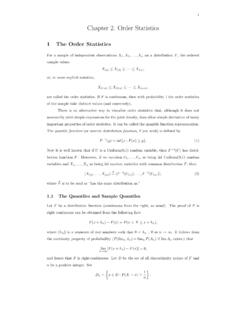Transcription of QR Factorization and Singular Value Decomposition
1 QR Factorization and Singular Value Decomposition COS 323 Last time Solving non-linear least squares Newton, Gauss-Newton, Levenberg-Marquardt methods Intro to logistic regresion Dealing with outliers and bad data: Robust regression, least absolute deviation, and iteratively re-weighted least-squares Practical considerations Solving with Excel and Matlab Today How do we solve without incurring condition-squaring effect of normal equations (ATAx = ATb) when A is Singular , fat , or otherwise poorly-specified? QR Factorization Householder method Singular Value Decomposition Total least squares Practical notes Review: Condition Number Cond(A) is function of A Cond(A) >= 1, bigger is bad Measures how change in input is propogated to change in output , if cond(A) = 451 then can lose log(451)= digits of accuracy in x, compared to precision of A || x||||x|| cond(A)|| A||||A||Normal Equations are Bad Normal equations involves solving ATAx = ATb cond(ATA) = [cond(A)]2 , if cond(A) = 451 then can lose log(4512) = digits of accuracy, compared to precision of A || x||||x|| cond(A)|| A||||A||QR Decomposition What if we didn t have to use ATA?
2 Suppose we are lucky : Upper triangular matrices are nice! ## #0##00 0 0#0 0 00 0 x ####### RO x=bHow to make A upper-triangular? Gaussian elimination? Applying elimination yields MAx = Mb Want to find x minimizes ||Mb-MAx||2 Problem: ||Mv||2 != ||v||2 ( , M might stretch a vector v) Another problem: M may stretch different vectors differently , M does not preserve Euclidean norm , x that minimizes ||Mb-MAx|| may not be same x that minimizes Ax=b QR Factorization Can t usually find R such Can find Q, R such that If Q orthogonal, doesn t change least-squares solution QTQ=I, columns of Q are orthonormal , Q preserves Euclidean norm: ||Qv||2=||v||2 A=QRO , so RO x=QTb A=RO Goal of QR A=QRO =Q?
3 ?..?0 0 0? mxn mxm mxn R: nxn, upper tri. O: (m-n)xn, all zeros Reformulating Least Squares using QR r22=b Ax22=b QRO x22=QTb QTQRO x22=QTb RO x22=c1 Rx+c222=c1 Rx22+c222=c222 A=QRO because because Q is orthogonal (QTQ=I) if we call QTb=c1c2 if we choose x such that Rx=c1 Householder Method for Computing QR Decomposition Orthogonalization for Factorization Rough idea: For each i-th column of A, zero out rows i+1 and lower Accomplish this by multiplying A with an orthogonal matrix Hi Equivalently, apply an orthogonal transformation to the i-th column ( , rotation, reflection) Q becomes product H1*..*Hn, R contains zero-ed out columns A=QRO Householder Transformation Accomplishes the critical sub-step of Factorization : Given any vector ( , a column of A), reflect it so that its last p elements become 0.
4 Reflection preserves length (Euclidean norm) Computing Householder if a is the k-th column: Exercise: Show H is orthogonal (HTH=I) a=a1a2 v=0a2 ek where = signak()a22apply H to a and columns to the right:Hu=u 2vTuvTv v (*with some shortcuts - see p124)Outcome of Householder where QT= Q= A=QRO Review: Least Squares using QR r22=b Ax22=b QRO x22=QTb QTQRO x22=QTb RO x22=c1 Rx+c222=c1 Rx22+c222=c222 A=QRO because because Q is orthogonal (QTQ=I) if we call QTb=c1c2 if we choose x such that Rx=c1 Using Householder Iteratively compute H1, H2, .. Hn and apply to A to get R also apply to b to get Solve for Rx=c1 using back-substitution QTb=c1c2 Alternative Orthogonalization Methods Givens: Don t reflect; rotate instead Introduces zeroes into A one at a time More complicated implementation than Householder Useful when matrix is sparse Gram-Schmidt Iteratively express each new column vector as a linear combination of previous columns, plus some (normalized) orthogonal component Conceptually nice, but suffers from subtractive cancellation Singular Value Decomposition Motivation #1 Diagonal matrices are even nicer than triangular ones: #0000#0000 00 0#0 0 00 0 x ####### Motivation #2 What if you have fewer data points than parameters in your function?
5 , A is fat Intuitively, can t do standard least squares Recall that solution takes the form ATAx = ATb When A has more columns than rows, ATA is Singular : can t take its inverse, etc. Motivation #3 What if your data poorly constrains the function? Example: fitting to y=ax2+bx+c Underconstrained Least Squares Problem: if problem very close to Singular , roundoff error can have a huge effect Even on well-determined values! Can detect this: Uncertainty proportional to covariance C = (ATA)-1 In other words, unstable if ATA has small values More precisely, care if xT(ATA)x is small for any x Idea: if part of solution unstable, set answer to 0 Avoid corrupting good parts of answer Singular Value Decomposition (SVD) Handy mathematical technique that has application to many problems Given any m n matrix A, algorithm to find matrices U, V, and W such that A = U W VT U is m n and orthonormal W is n n and diagonal V is n n and orthonormal SVD Treat as black box: code widely available In Matlab: [U,W,V]=svd(A,0) SVD The wi are called the Singular values of A If A is Singular , some of the wi will be 0 In general rank(A) = number of nonzero wi SVD is mostly unique (up to permutation of Singular values, or if some wi are equal) SVD and Inverses Why is SVD so useful?
6 Application #1: inverses A-1=(VT)-1 W-1 U-1 = V W-1 UT Using fact that inverse = transpose for orthogonal matrices Since W is diagonal, W-1 also diagonal with reciprocals of entries of W SVD and the Pseudoinverse A-1=(VT)-1 W-1 U-1 = V W-1 UT This fails when some wi are 0 It s supposed to fail Singular matrix Happens when rectangular A is rank deficient Pseudoinverse: if wi=0, set 1/wi to 0 (!) Closest matrix to inverse Defined for all (even non-square, Singular , etc.) matrices Equal to (ATA)-1AT if ATA invertible SVD and Condition Number Singular values used to compute Euclidean (spectral) norm for a matrix: cond(A)= max(A) min(A)SVD and Least Squares Solving Ax=b by least squares: ATAx = ATb x = (ATA)-1 ATb Replace with A+: x = A+b Compute pseudoinverse using SVD Lets you see if data is Singular (< n nonzero Singular values) Even if not Singular , condition number tells you how stable the solution will be Set 1/wi to 0 if wi is small (even if not exactly 0) SVD and Matrix Similarity One common definition for the norm of a matrix is the Frobenius norm: Frobenius norm can be computed from SVD Euclidean (spectral) norm can also be computed: So changes to a matrix can be evaluated by looking at changes to Singular values A2={max.}
7 (A)}SVD and Matrix Similarity Suppose you want to find best rank-k approximation to A Answer: set all but the largest k Singular values to zero Can form compact representation by eliminating columns of U and V corresponding to zeroed wi SVD and Eigenvectors Let A=UWVT, and let xi be ith column of V Consider ATA xi: So elements of W are sqrt(eigenvalues) and columns of V are eigenvectors of ATA Total Least Squares One final least squares application Fitting a line: vertical vs. perpendicular error Total Least Squares Distance from point to line: where n is normal vector to line, a is a constant Minimize: Total Least Squares First, let s pretend we know n, solve for a Then Total Least Squares So, let s define and minimize Total Least Squares Write as linear system Have An=0 Problem: lots of n are solutions, including n=0 Standard least squares will, in fact, return n=0 Constrained Optimization Solution: constrain n to be unit length So, try to minimize |An|2 subject to |n|2=1 Expand in eigenvectors ei of ATA.
8 Where the i are eigenvalues of ATA Constrained Optimization To minimize subject to set min = 1, all other i = 0 That is, n is eigenvector of ATA with the smallest corresponding eigenvalue Comparison of Least Squares Methods Normal equations (ATAx = ATb) O(mn2) (using Cholesky) cond(ATA)=[cond(A)]2 Cholesky fails if cond(A)~1/sqrt(machine epsilon) Householder Usually best orthogonalization method O(mn2 - n3/3) operations Relative error is best possible for least squares Breaks if cond(A) ~ 1/(machine eps) SVD Expensive: mn2 + n3 with bad constant factor Can handle rank-deficiency, near-singularity Handy for many different things Matlab functions qr: explicit QR Factorization svd A\b: ( \ operator) Performs least-squares if A is m-by-n Uses QR Decomposition pinv: pseudoinverse rank: Uses SVD to compute rank of a matrix
